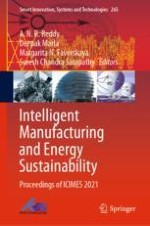2022 | Book
Intelligent Manufacturing and Energy Sustainability
Proceedings of ICIMES 2021
Editors: Prof. Dr. A. N. R. Reddy, Prof. Dr. Deepak Marla, Prof. Dr. Margarita N. Favorskaya, Prof. Dr. Dr. Suresh Chandra Satapathy
Publisher: Springer Singapore
Book Series : Smart Innovation, Systems and Technologies
